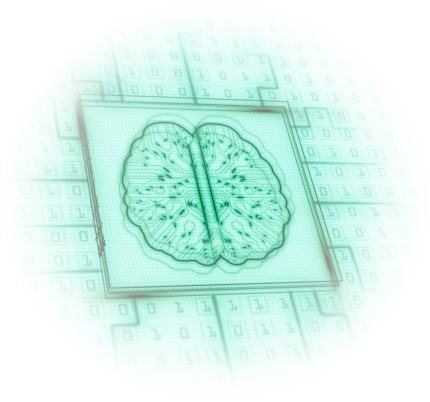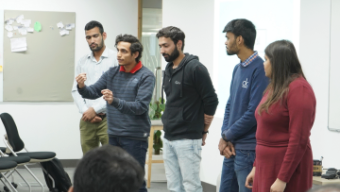UG Programs | 4 years
B.Tech in Computer Science & Artificial Intelligence
Increasing access to computing power & explosion of digital data coupled with advances in AI are transforming every aspect of human life. The Computer Science & Artificial Intelligence program is not a traditional Computer Science degree, but combines a Computer Science core with machine learning, artificial intelligence, & human intelligence with a long term view that computing systems will be pervasive & that the interface of human & artificial intelligence will be a source of future grand challenges & opportunities for innovation.
Round 1 – Nov 24, 2021 to Jan 14, 2022

8 Semester Curriculum
The curriculum at Plaksha is dynamic and continuously evolving, based on inputs from faculty, latest research and industry insights.
Semester 1
Semester 2
Semester 3
Semester 4
Semester 5
Semester 6
Semester 7
Semester 8
Semester 1
This course, referred to as ILGC, introduces the Grand Challenges at the interface of societal needs and technological capabilities. It will offer the opportunity for students to develop an interdisciplinary appreciation for engineering from a technical perspective as well as from a global and historical perspective. Students will embark on this integrated, project-based journey in the 1st semester and work on different projects throughout the four-year program. First semester topics include – Exposure to different Grand Challenges and project areas, design cycle, grand challenge thinking, geopolitics and global awareness, and entrepreneurial mindset
What are the assumptions and beliefs that we have not examined in the modern age? How do we become aware of our implicit beliefs? What possibilities open up if we investigate and examine our presuppositions? How can we respond to the Grand Challenges of our time, if we don’t know how to think and reason critically? In this course, you will learn to meticulously develop the skill of thinking and enquiring critically, and being able to reason in a scientific, evidence-based manner. The course will focus on sharpening your intellectual abilities so that thinking critically and scientifically becomes a natural way of approaching the world. You will learn how to carefully analyze texts, structure arguments, develop technical reading and writing skills, and communicate your ideas in a coherent and logical manner to different audiences. Additionally, you will also learn to evaluate hypotheses and causal claims, observe and analyze data and patterns, construct reason-based arguments, and draw logical conclusions.
In this course, students will be introduced to foundational aspects of engineering mathematics, specifically linear algebra, matrices, and ordinary differential equations. The course is divided into four modules, two modules each on linear algebra and ordinary differential equations. The topics included under the linear algebra modules are definition of vector spaces, concepts on linear independence of vectors, bases, rank of a matrix, solutions to linear systems, definition and interpretation of eigenvalue problems, and singular value decomposition and their applications. The topics under ordinary differential equations are methods to solve simple linear differential equations using both analytical (method of undetermined coefficients, variation of parameters) and numerical techniques (Runge-Kutta methods), basics of phase plane analysis, stability of solutions based on eigenvalue analysis, fixed points, and elementary concepts on bifurcation and chaos. Each module will comprise a computer-based laboratory project.
This course provides students with an understanding of the role that computational thinking can play in solving problems. Students will be exposed to varied real-world problems and be taught how to approach them and design solutions using Python. In addition to learning key computing skills and concepts, the course will focus on how existing features in programming languages can be used to implement different concepts efficiently and how one can analyze different solutions. After taking the course students are expected to work on real-world projects that require building logical thinking processes that break down complex problems into smaller parts.
In this course, students will be introduced to classical mechanics, quantum mechanics, statistical mechanics, and connections to engineering thermodynamics. Molecular origin of macroscopic descriptions and constitutive relations for equilibrium and non-equilibrium behavior; fluctuations, kinetics, and limitations of macroscopic descriptions. Macroscale continuum origin of lumped models: ‘through’ and ‘across’ variables for analysis of electrical, mechanical, structural, thermal, acoustic, and fluidic systems
This course introduces students to harness the power of design thinking to develop innovative solutions to complex human-centered problems. The design thinking methodology will help students learn about the underlying context and the innovation need, brainstorming and developing prototypes, testing potential solutions, improving them, and developing new insights. Students will be exposed to core technology and design themes including principles, modes of thinking and analysis, and social and cultural aspects of design. They will learn how to use the ideation process to generate new ideas and select promising solutions, use prototyping tools to visualize and communicate ideas and develop the implementation plan for an effective solution.
Semester 2
Building on the ILGC journey from Semester 1, ILGC II will introduce students to starting their team projects, implementing principles of Design Thinking, embarking on a campus-wide project, and interacting with real-world stakeholders. Students will also learn how to work with various tools and build skills in machining, programming, instrumentation, among others.
In this course, we will rigorously enquire into the different meanings of the idea of technology and its relationship to society from the perspectives of philosophy, history, social anthropology, human evolution, and civilizational studies. We will look at examples from the past and present, but more importantly, also start imagining what the relationship between technology and society could be in the future. We will ask a number of questions pertinent to this inquiry: Does technology influence society, or, does society influence technology? What indeed is technology? Is technology perhaps first and foremost an ‘idea’? Or, is technology a particular way of knowing the world around us? If it is an idea then it must involve thinking of some kind. But clearly it also involves making something – usually an object that does something or has a particular function. In this course we will begin to understand technology from the standpoint of the threefold matrix of thinking, knowing, and making
This is an introductory level UG course on probability and statistics. Topics include conceptual introduction to probability axioms, conditional probability, Bayes’ theorem, law of total probability and expectation, measures on central tendency and dispersion, probability distributions, simple discrete and continuous probability distribution models, elementary concepts on discrete and continuous time Markov processes, least squares regression analysis, sampling distributions and elementary ideas on hypothesis tests. Students will have to complete an end-of-term project on a topic of their choice.
Building on the Python course taught in the previous semester, students will be introduced to the Object Oriented Programming (OOP) paradigm and the associated benefits. They will learn to write structured and efficient programs in the OOP style. Besides testing and debugging programs, students will learn about common data structures, and where and how to apply them to solve computational problems.
This course introduces students to how nature’s machines work. It covers various aspects that relate the design of living matter/things to engineering. We will discover how to think about: a) the human cell as a factory, the circulatory system as a transport network, musco-skeletal system as a structural network for load-bearing, magnetoreception in animals as a communication system, among other topics. b) Aspects of biomedicine such as the design of impedimetric sensors, digital health, and tissue and genetic engineering. c) Diversity and dynamics of nature pertinent to engineering through several demo examples and recent state-of-the-art applications.
The course introduces core microeconomic models of consumers, firms, and markets, and develops their application to a broad range of economic and social issues in the real world. It will cover concepts of equilibrium, markets and competition, market demand and market supply, behavior of consumers and producers, consumer and producer theory, pricing, tax incidence, making choices under uncertainty, economic efficiency, etc., in the context of contemporary real-world applications around us such as Uber surge pricing, telecom price wars, e-commerce models, recent ed-tech acquisitions, etc
Semester 3
In this course, students continue to build on their IL/GC projects, with an eye for expansion at the city level. They will be able to develop multidisciplinary approaches and interdisciplinary perspectives by interacting with and making connections between disciplines; analyzing the humanistic, social, historical, economic, and technical contexts of problems. In addition, they will continue to iterate their designs and work on skills such as developing innovation and entrepreneurial mindset, becoming a better communicator and leader, and understanding the social and human consequences of actions and responsibilities to others in local, national, and global communities.
The advent of technology since the turn of the century has led to many advancements in the way that humans live and operate. This progress, however, also comes with apprehensions, uncertainty, and questions regarding the ethical considerations associated with the owners, regulators, and users of the technology. In this course, we will examine the manifold ethical issues surrounding the use and development of AI, Robotics, Biology, and Business based technologies in the contemporary world. Students will be introduced to ideas of safety, privacy, regulations, and related consequences of bias, manipulation, and fairness, from a multidisciplinary perspective. Students will be introduced to ideas from traditional philosophical ethics texts before delving into real world case studies focussing on contemporary issues.
This course will introduce foundational ideas on mathematical transforms like Laplace and Fourier transforms. Additionally, there will be a two month long module on partial differential equations and vector calculus. In addition to lectures, students will participate in a semester long, state of the art physical laboratory immersion program which will involve training and tinkering with experimental mathematics, such as profiling heat conduction through a metallic rod to understand the mechanics of the heat equation and its solutions, performing fluid mechanics experiments using a rotating tank of water and high-speed camera to collect data and understand the solution states of the Navier Stokes equation, using wavemaker and wave guides to calculate wave velocity and comparing the data with theoretical calculations, performing laboratory experiments with spectrometers to estimate power spectral density of signals and compare the results with mathematical calculations in Fourier space, etc.
This course offers an introduction to the areas of Data Science, Artificial Intelligence, and Machine Learning (DS/AI/ML), combining philosophical, biological, and psychological perspectives with computational design concerns. Students will begin the course by understanding the principles underlying learning and how it translates to various applications and categories of AI. Besides multiple classes of models, students will be introduced to fundamental concepts in data science that will help them identify, compare and implement solutions to problems. Internal critiques and external perspectives of AI solutions will also be discussed to ensure students obtain a holistic view of the challenges and opportunities in this field.
This course introduces the students to the idea of intelligence and how intelligent machines are transforming the world around us. Students will learn about the concept of cyber-physical systems and how intelligence stems from the ‘perception, reasoning, and action loop’. Students will explore several examples of cyber-physical systems in the real world in areas such as robotics, smart grids, and autonomous cars. They will learn about mathematical techniques for modeling cyber-physical systems, how to build intelligent machines by combining sensors, actuators, and embedded devices. Through hands-on lab activities, assignments, projects, as well as through guest lectures spanning research and practice, students will be able to gain the skills to design, build and evaluate simple cyber-physical systems that will give them the confidence to pursue more complex projects in their future endeavors.
This course offers a multidisciplinary overview of the field of optimization. Students will learn how to formulate an optimization problem, apply different optimization techniques, translate problems into Python and Matlab code, and identify conditions under which each one works best. Students will be introduced to numerical, constrained, unconstrained, univariate and multivariate optimization methods and techniques, while also being introduced to topics such as Pareto optimality, multiobjective and global optimization. The final project will allow students to apply their knowledge to real-world engineering and business problems.
Semester 4
In Semester 4 students will decide the IL/GC project (coincides with choosing their major) and team they will be part of, and initiate the first steps of the project that will culminate with their capstone. Projects chosen by students will be connected and coherent in design, looping in a wide range of technology such as sensors, IoT, automation, robots, AI/ML, data science, biosystems design, etc. The core focus would be on implementing the engineering design cycle and reflecting on progress, to create solutions implementable at a city level, with an eye for expansion at state level. Mentored Leadership and Professional Development opportunities will be a constant feature across the 4 year IL/GC experience, and will be integrated with project work. These serve to develop the student’s professional skills and also help in creating a more integrated socio-integrated understanding of engineering/design.
Modern computers of all scales rely on efficient algorithms for solving diverse sets of computing problems. Efficient data structures are the backbone of efficient algorithms, guiding the scheme of storage and retrieval of data for speedy and effective processing. This course enables students to recognise the best data structures suited for a given computing problem, design algorithms based on them, and prove bounds on time and space complexity of their algorithms. As part of the course work, the students will also study the implementation and complexity of fundamental algorithms such as max flow in networks, discrete fourier transform, RSA cryptosystem, and real-world systems such as google search engine, and social network graphs.
The advent of deep learning and its application to big data analysis has worked to transform our industries. This course is meant to give students a detailed introduction to the science of deep learning. We undertake a study of various neural network architectures adapted to different problem settings, their training parameters, and algorithms for optimal network training and performance. We organise the discussion around existing learning paradigms and the specificities of data that guide the network design (via inductive biases). We anchor the study around seminal papers that have, and that continue, to shape the field of deep learning, to give students a flavour for the dynamic nature of the field. As part of the lab work, students will be expected to apply these concepts to real world problems that involve the development of ML-based modules for core tasks such as scene recognition, speech recognition, image segmentation, etc.
This course introduces the basic concepts that serve as a basis for understanding the design space of programming languages in terms of their constructs, paradigms, evaluation criteria and language implementation issues. It introduces concepts from imperative, object-oriented, functional, logic-based, constraint-based and concurrent programming. These concepts are illustrated by examples from varieties of languages such as C/C++, Java/C#, Smalltalk, Scheme, Haskell, Prolog, Erlang, Julia, Rust. The module also introduces various implementation issues, such as static and dynamic semantics, abstract machines, type inferencing, etc. This course uses a uniform notation to specify progressively the programming models of most programming languages. These models range from declarative models that cover functional programming and dataflow computing to stateful models for imperative and object-oriented programming, as well as concurrent models for message-passing systems and shared state.
The course provides a broad understanding of Computer Systems, starting with an emphasis on a programmer’s view of computer hardware, and leading into system-level hardware and software components. We will explore how a line of code in high level language is translated through layers of software to the target language of the machine. The course will then provide practical treatment of how best a programmer may leverage the machine hardware features for performance, power, security through good software practices. The course will also provide a general understanding of the system software involved for an application program to run, both on a single node and over a network, and how this system software is to be used. In support of this objective, the course will prepare students to do system-level programming. This course will show how to “use” (as opposed to “design”) system components, such as memory, file systems, process control, inter-process communication, and networking. By the end of this course students are expected to have an understanding of the problems and pitfalls typically encountered in the design and implementation of multi-threaded and networked applications and systems. By the end of this course students will have also acquired basic knowledge and skills to write performant code, recognize code optimization, and make full use of the services provided by the underlying operating system by programming directly at the operating system interface level.
The Application Domain Tracks are a series of 1 credit modules that help students inculcate skills and mindsets related to research and entrepreneurship. Through these tracks, students will contribute to ongoing research projects in Plaksha’s flagship grand challenge research centers, and may work with faculty on their research or on approved external projects in industry/government or startups. Across semesters, students will have the option to work across different disciplinary areas or focus on one area but the purpose is for them to appreciate the relevance of their coursework to a variety of challenges and areas.
Semester 5
Continuing their project progress from semester 4, the goal for Semester 5 and 6 will be to implement solutions via projects at the State level, with an eye for expansion at the National level. To achieve this, students will seek validation of concept from various stakeholders, complete the engineering design cycle of their project, while also developing an entrepreneurial spirit from their experiences. Mentored Leadership and Professional Development opportunities will be a constant feature across the 4 year IL/GC experience, and will be integrated with project work. These serve to develop the student’s professional skills and also help in creating a more integrated socio-integrated understanding of engineering/design.
In this course, students will learn how the sequential, uniprocessor system design concepts and components are scaled to solve extremely large-scale computational problems. Specifically, this course seeks to examine the process (including engineering tradeoffs) of how the components – compute, storage, network, and software – scale-up to address the challenges of computing that involves large data subjected to concurrent, fast, reliable, secure, and energy efficient computing. Traditional and evolving models of parallel and distributed computing will be studied against the backdrop of modern applications from fields such as machine learning, high-performance computing, and internet of things.
The objective of this course is an in-depth study of data storage and its management in filesystems, key-value stores and database management systems, and their respective application domains. After discussing the basics of filesystems, key-value stores and the related NoSQL stores, the course will cover the use of databases as a tool for data management, and the theory and systems concepts behind relational and NoSQL databases. As a part of database design, the course will cover ER diagrams, SQL, schema and view management, query processing and optimization, indexing, data integrity and normalization, transaction management, security, large-scale distributed data processing with NoSQL databases.
Large portion of information in our lived environment is available in the form of visual images. Repositories of photographs and videos, ranging widely from true colour to remote sensing imagery, are growing exponentially, and contain a wealth of information. The ability to extract relevant details from visual data is thus a key component of many practical systems (e.g. systems for climate change assessment, disaster response, vehicle navigation etc), and particularly systems that must exhibit artificial intelligence. This course complements the earlier course on machine learning and neural networks whilst going deeper into the realm of machine learning for visual perception. We start from the roots of computer vision, in the fields of signal processing, and more specifically, digital image processing. We develop the notion of convolutional neural networks as a hierarchy of filters adapted to an end task. We discuss different algorithms for visual inference in their original (hand-designed), and current (neural) form. As part of the lab work students will learn to design, implement and benchmark different neural network models for computer vision, and build intuition about the use-cases of these models, and their performance, robustness and safety implications.
Students may take courses from other majors as part of the free elective. Additionally, faculty may also offer some introductory electives as part of this sequence.
The Application Domain Tracks are a series of 1 credit modules that help students inculcate skills and mindsets related to research and entrepreneurship. Through these tracks, students will contribute to ongoing research projects in Plaksha’s flagship grand challenge research centers, and may work with faculty on their research or on approved external projects in industry/government or startups. Across semesters, students will have the option to work across different disciplinary areas or focus on one area but the purpose is for them to appreciate the relevance of their coursework to a variety of challenges and areas.
Semester 6
Continuing their project progress from semester 4, the goal for Semester 5 and 6 will be to implement solutions via projects at the State level, with an eye for expansion at the National level. To achieve this, students will seek validation of concept from various stakeholders, complete the engineering design cycle of their project, while also developing an entrepreneurial spirit from their experiences. Mentored Leadership and Professional Development opportunities will be a constant feature across the 4 year IL/GC experience, and will be integrated with project work. These serve to develop the student’s professional skills and also help in creating a more integrated socio-integrated understanding of engineering/design.
This is an introductory course that sits between the domains of statistics, mathematics, machine learning and knowledge discovery. The aim of this course is to give a sweeping exposure to various concepts and mathematical techniques for profiling data sets, analysing them in an open-ended exploratory manner or task-specific targeted manner, building hypotheses and testing them. Along the way, we will cover topics such as data transformation, similarity and dissimilarity indices, data dimensionality reduction, descriptive statistics, predictive modelling, clustering analysis, data visualisation, and evaluation metrics. We will build intuition by working through real world examples. And acquire practical skills by applying our toolkit to reveal patterns and glean insights from wide ranging datasets from the fields of social sciences, medical sciences, natural sciences, financial market, business, etc.
This course will introduce students to software engineering approaches used in industry, with emphasis on specifying software implementation and testing. Course contents include the Agile software development approach, best practices in coding style, test-case driven development, testing approaches, and software metrics. All through the semester, student teams will participate in a substantial coding project probably catering to the needs of local businesses. In the concluding month, industry speakers will elaborate on the software engineering practices followed in their respective companies.
The course will teach students to build natural language processing systems by processing text, including tokenizing and representing sentences as vectors, RNNs, GRUs, LSTMs and Attention mechanisms for machine translation. Upon completion, the student will be expected to recognize NLP related tasks in day-to-day scenarios and propose approaches that are likely to work well for the scenarios. A brief introduction to Indian NLP will also be part of the course along with a discussion of earlier approaches to NLP.
Students may take courses from other majors as part of the free elective. Additionally, faculty may also offer some introductory electives as part of this sequence.
The Application Domain Tracks are a series of 1 credit modules that help students inculcate skills and mindsets related to research and entrepreneurship. Through these tracks, students will contribute to ongoing research projects in Plaksha’s flagship grand challenge research centers, and may work with faculty on their research or on approved external projects in industry/government or startups. Across semesters, students will have the option to work across different disciplinary areas or focus on one area but the purpose is for them to appreciate the relevance of their coursework to a variety of challenges and areas.
Semester 7
In this course, students will learn about different kinds of security problems, with real-life examples, and how to detect and defend against them. The course will broadly cover the following aspects of systems security – basics of security modelling; security policies and mechanisms; hardware security, security of software at programming language level and at the network and web levels; types of attacks and its prevention and defence; basics of cryptography including encryption and decryption algorithms; case studies of serious security incidents and their root cause analyses.
Sample Electives include: Cloud Computing, Design of AI Products, Human Computer Interaction, Neural Computing, Data Analytics and Visualisation, Deep Reinforcement Learning, Quantum Computing
Sample Electives include: Cloud Computing, Design of AI Products, Human Computer Interaction, Neural Computing, Data Analytics and Visualisation, Deep Reinforcement Learning, Quantum Computing
Sample electives include: Neuroscience, Brain Science, Human Cognition Perception and Memory, Cognitive Psychology, Language and Thought
ILGC transforms and culminates as a two semester capstone design project. By the end of the seventh semester a detailed design of the final product (this could be a device, system, process, software, etc. that results from this design experience) needs to be completed. This includes but not limited to the following: Description of the overall project, including a description of the customer and their requirements, the purpose, specifications, and a summary of the approach. Description of the different design approaches considered and evaluation of each design approach. Detailed description of the final proposed design.
Semester 8
This course is envisioned to be offered in a seminar format where the instructor will provide motivating elements to spur student-led investigative research in contemporary and emerging topics in the fields of machine learning, artificial intelligence, and data science. Students will learn to engage in scientific investigation and report their findings in seminar format.
Sample Electives include: Cloud Computing, Design of AI Products, Human Computer Interaction, Neural Computing, Data Analytics and Visualisation, Deep Reinforcement Learning, Quantum Computing
Sample electives include: Neuroscience, Brain Science, Human Cognition Perception and Memory, Cognitive Psychology, Language and Thought
Sample electives include: AI for Social Good, Technology, Policy and Law, Decision Making Under Uncertainty, Fairness, Transparency, Accountability, and Ethics in Data Science
ILGC transforms and culminates as a two semester capstone design project. By the end of the eighth semester, students will have a working product (this could be a device, system, process, software, etc. that results from this design experience). Therefore, the focus of this semester is to implement, test and evaluate the design approach chosen in your first semester. The following are the expected requirements and deliverables for this semester: Working final product Testing and evaluation of product design Demo of the final product Completed Project Description, Final Reflection and Completed Outcomes Matrix
What can you create?

Recognition Systems
You can build higher quality and safer AI based facial recognition technologies and voice recognition systems to run our processes and applications, biometrics to secure our identities on public systems and a huge number of applications in our daily lives.

Personalized learning systems
You can build AI based personalized learning systems that are paced as per individual preference, adapted to your interests, and have intelligent AI based tutors who help you just where you need it – to make your learning journey effective, adventurous and your own!

AI-based health solutions
You can create AI based healthcare start-ups that help predict and diagnose diseases such as cancer and tuberculosis early with higher accuracy, through deep learning algorithms and image recognition technologies.

Music, art and more
Companies already use big data to help people discover amazing new music and movies aligned to their tastes, find clothes they like better and more. Soon you can even use AI to create hit songs (look up “Not Easy”), create best-selling art and anything else you imagine!
Learning Experiences

Multidisciplinary approach & interdisciplinary perspective
Interacting with and drawing from multiple fields of expertise, making connections between disciplines, analyzing the humanistic, socio-economic, and technical contexts of problems

Foundational Tech core
Developing an interdisciplinary foundation featuring math, physics, computer science and engineering principles such that they come together as an integrated whole, not segmented topics.

Design & research ability
Identifying and understanding human needs and solving problems creatively through sustained critical investigation.

Innovation & entrepreneurship mindset
Finding opportunities, identifying business models, embracing ambiguity to create value in the marketplace or in society.

Societal responsibility
Considering the social and human consequences of actions and responsibilities to others in local, national, and global communities; acting to improve the human condition.

Leadership & self-reflection
Creating impact through actively developing skills like communication, creativity, critical thinking and collaboration.
Experiential Learning
Integrated learning experience across 4 years. You will work on authentic, real world projects through industry and community engagement or by research with faculty.
Coding Cafe and Makerspaces
Entrepreneurship
Student led clubs
Coding Cafe and Makerspaces

By having access to state-of-the-art makerspaces and coding cafes and incorporating them in the curriculum, students will become more context-aware, develop critical thinking abilities, and learn by creating. This will help foster a tinkering and problem solving mindset, immersing students in experiential learning from day one. These areas will be open to students to explore, create, prototype and design, while also housing equipment and technologies like 3D printers, sensors, etc.
Entrepreneurship

The core curriculum will not just be limited to engineering and sciences, but bring in exposure to entrepreneurship and design which will enable humane and empathetic outcomes through technology. Each student will undertake multiple different experiences to develop skills like finding opportunities, creating value, and embracing risks.
Student led clubs

At Plaksha, learning and skill development do not stop in the classroom. Students will have the opportunity to create and immerse themselves in pursuing their academic and creative interests. Student led clubs will be autonomous bodies that operate under the purview of the Office of Student Life.
Hear about the course from the experts
Watch Srikanth Velamakanni, Founder and Trustee, Plaksha University as he explains the relevance and scope of this B.Tech. degree.
Find the answers to your questions in some of our frequently asked questions by students
Dates to Remember
Jan 14, 2022
Round 1 Deadline
March 31, 2022
Round 2 Deadline
June 12, 2022
Round 3 Deadline*
July 20, 2022
Round 4 Deadline*
Up Next



